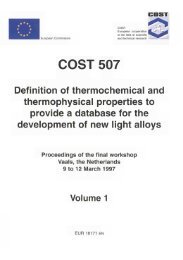Susana Isabel Ferreira da Silva de Sá ESTROGÉNIOS E ...
Susana Isabel Ferreira da Silva de Sá ESTROGÉNIOS E ...
Susana Isabel Ferreira da Silva de Sá ESTROGÉNIOS E ...
You also want an ePaper? Increase the reach of your titles
YUMPU automatically turns print PDFs into web optimized ePapers that Google loves.
from pairs of alternate sections and each section was used in turn<br />
as the reference section or the look-up section, 45 disectors were<br />
performed, on average, per nucleus. The sections were analyzed<br />
using a modified Olympus BH-2 microscope interfaced with a<br />
color vi<strong>de</strong>o camera and equipped with a Hei<strong>de</strong>nhain ND 281<br />
microcator (Traunreut, Germany), a computerized stage, and an<br />
object rotator (Olympus, Albertslund, Denmark). A computer fitted<br />
with a framegrabber (Screen Machine II, FAST Multimedia,<br />
Germany) was connected to the monitor. By using the C.A.S.T. –<br />
Grid system software (Olympus), two counting frames equivalent<br />
in shape and area (15,947 µm 2 ) were superimposed onto the<br />
tissue images on the screen. The image of one section was frozen<br />
on the left half si<strong>de</strong> of the screen and compared with the image of<br />
the adjacent section displayed on the right si<strong>de</strong> of the screen.<br />
Neurons were counted, at final magnification of 800×, when their<br />
nuclei (the counting unit) were visible in the reference section (the<br />
right si<strong>de</strong>d image), but not in the look-up section (the left si<strong>de</strong>d<br />
image), within the counting frame without being intersected by the<br />
exclusion edges or their extensions. An average of 200 neurons<br />
was counted per each VMNvl.<br />
The number of synapses per unit volume of neuropil (numerical<br />
<strong>de</strong>nsity, Nv) was estimated by using the physical disector method<br />
applied to electron micrograph prints (Ma<strong>de</strong>ira and Paula-<br />
Barbosa, 1993; <strong>Sá</strong> and Ma<strong>de</strong>ira, 2005a; Sterio, 1984). For this<br />
purpose, two series of 7 electron micrographs of corresponding<br />
fields of the neuropil were taken at primary magnification of<br />
5,400× from the ultrathin sections obtained as <strong>de</strong>scribed above.<br />
The micrographs were then enlarged photographically to a final<br />
magnification of 16,200×. Disectors were ma<strong>de</strong> from micrographs<br />
obtained from pairs of alternate sections. Because each section<br />
was used in turn as the reference section, 40 disectors were ma<strong>de</strong><br />
per animal. A transparency with an unbiased counting frame was<br />
superimposed onto the reference section micrograph. A synapse<br />
was counted whenever its postsynaptic <strong>de</strong>nsity (the counting unit)<br />
was seen entirely or partly within the counting frame without<br />
intersecting the forbid<strong>de</strong>n lines and their extensions in the<br />
reference section, but not in the look-up section. Synapses were<br />
i<strong>de</strong>ntified by the presence of synaptic <strong>de</strong>nsities, at least three<br />
synaptic vesicles at the presynaptic site and a synaptic cleft<br />
(Colonnier, 1968; Gray and Guillery, 1966). Because the number<br />
of symmetrical synapses received by the <strong>de</strong>ndritic trees of VMNvl<br />
neurons is very low (Field, 1972; Nishizuka and Pfaff, 1989), for<br />
the purpose of the estimations herein performed no distinction<br />
was ma<strong>de</strong> between symmetrical and asymmetrical synapses. The<br />
mean thickness of the ultrathin sections, estimated using the<br />
minimal fold technique (Small, 1968), was 70 nm. On average,<br />
200 synapses were counted per animal.<br />
4.7. Estimation of the total number of PR-immunoreactive<br />
neurons<br />
The estimates were obtained using the computerized stereology<br />
system <strong>de</strong>scribed above and by applying the optical fractionator<br />
method (Ma<strong>de</strong>ira et al., 1997; West et al., 1991) to an average of<br />
11 sections per VMNvl analyzed. In each section, the fields of<br />
view were systematically sampled using an interframe distance of<br />
70 µm along the x and y axes. The disector used had a counting<br />
frame area of 1482 µm 2 at the tissue level and a fixed <strong>de</strong>pth of 10<br />
µm. The estimations were performed, at final magnification of<br />
2000×. Positive PR immunoreactivity was i<strong>de</strong>ntified as <strong>da</strong>rk brown<br />
nuclear staining. On average, 350 PR-immunoreactive cells were<br />
counted per nucleus; the mean coefficient of error (CE;<br />
Gun<strong>de</strong>rsen et al., 1999) of the estimates was 0.07.<br />
4.8. Statistical analyses<br />
The Stu<strong>de</strong>nt´s t-test for in<strong>de</strong>pen<strong>de</strong>nt variables was used to<br />
examine the influence of EB treatment in hormone levels and<br />
uterine weights. A two-way analysis of variance (ANOVA) with<br />
<strong>de</strong>afferentation and EB treatment as the in<strong>de</strong>pen<strong>de</strong>nt variables<br />
was applied to the remaining <strong>da</strong>ta. Whenever significant results<br />
were found from the overall ANOVA, pair-wise comparisons were<br />
subsequently ma<strong>de</strong> using the post hoc Tukey’s HSD test.<br />
Differences were consi<strong>de</strong>red significant if p

















